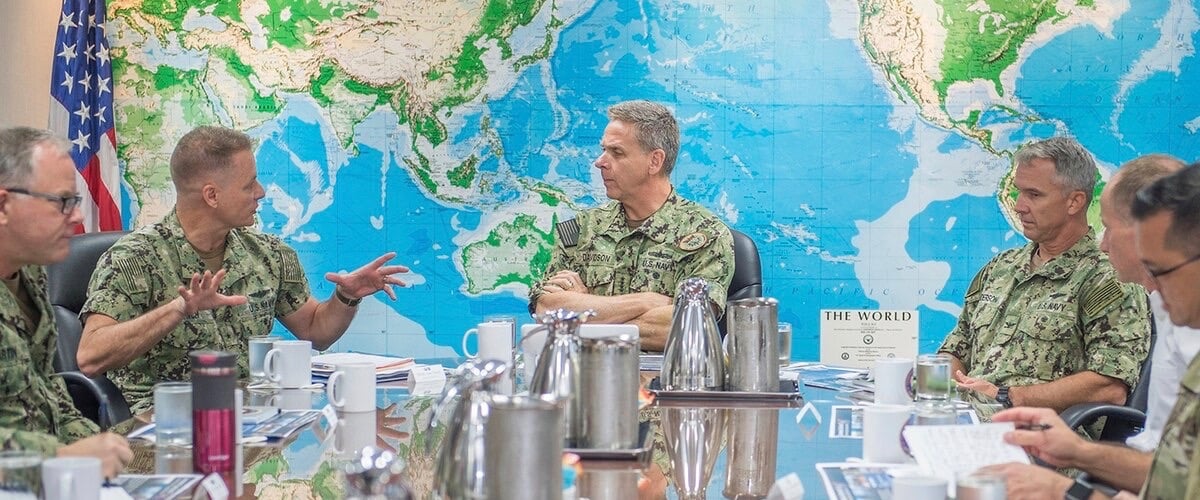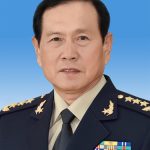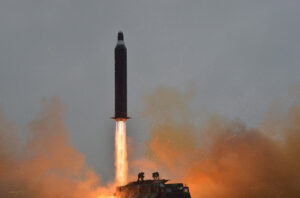
Adm. Phil Davidson, INDO-PACOM commander, being briefed in Singapore
Adm. Philip Davidson displays a large model of Fiery Cross Reef — one of seven fake islands Beijing has built by destroying shallow reefs in the South China Sea — in the anteroom to his office at Indo-Pacific Command headquarters.
Chinese President Xi Jinping publicly promised in 2015 not to “militarize” those “islands, which lie in an area an international tribunal ruled does not belong to China. But, as the model in Davidson’s office makes clear, Fiery Cross bristles with military facilities, including an airstrip, anti-ship and surface-to-air (SAM) missiles. “What my predecessor called a ‘Great Wall of Sand’ three years ago is now a ‘Great Wall of SAMs,’” Davidson recently warned.
Breaking Defense contributor James Kitfield recently visited Adm. Davidson, commander of Indo-Pacific Command, in his Camp Smith, Hawaii office, with its expansive views of Pearl Harbor and Honolulu in the distance. Edited excerpts from their interview follow.
BD: In his recent confirmation hearing to become the next Chairman of the Joint Chiefs of Staff, Gen. Mark Milley said that China will be the United States’ chief military rival for the next 50 to 100 years. As the U.S. military commander at the forefront of that rivalry, does this look to you like the emergence of a new Cold War with China?
Davidson: I disagree with the use of the phrase “New Cold War” when discussing the Chinese challenge. Our approach and desire is not to try and “contain” China like we contained the Soviet Union. We have a very close and productive economic relationship with China. We fully expect all nations to have an economic relationship with China. We welcome China’s participation in a rules-based international order (emphasis added), and remind Beijing frequently of the prosperity that order has created, liberating hundreds of millions of people and literally lifting billions of people out of poverty. So I don’t like the “Cold War” analogy, because we did try and contain the Soviet Union, and instead we welcome China into the global economic order.
BD: Yet isn’t China increasingly inclined to break the rules which govern that order when they don’t suit Chinese interests?
Davidson: The international order is now under assault by China, and various other international actors, and we can’t ignore that. The United States and China have a fundamental divergence of values in terms of how we approach the current international order.
BD: Where do you see that divergence of values most acutely from your perspective?
Davidson: You can see it in the Indo-Pacific region in China’s militarization of man-made islands in the South China Sea in defiance of international tribunals. You can see it in the predatory economic policies behind China’s “One Belt, One Road” initiative, which ignores WTO [World Trade Organization] rules on transparency and corruptly entices countries into a debt trap that forces them to trade their sovereignty in order to avoid a debt default. You can see that divergence of values in how China is treating Muslim Uighurs in Western China (by reportedly interning one million of them in “re-education” camps). You can that divergence of values in the recent democracy protests by the people of Hong Kong.
BD: Do you agree with a number of prominent experts who have recently warned that China is trying to replace the liberal international order with one more favorable to its brand of authoritarianism and mercantilist capitalism?
Davidson: All of those instances I just cited do suggest that China is looking to supplant the rules-based international order with one with Chinese characteristics, which has a very chilling effect on the rest of the world. They do recognize that world order as one that favors authoritarianism. So that does represent a fundamental divergence in our vision of a free and open international order, compared to the one that China would prefer.
BD: For decades the U.S. strategy towards China was based on the belief that, as it was integrated more closely into the global economy, Beijing would become more liberal and democratic politically. What happened?
Davidson: The old strategy presuming that China would liberalize as it was integrated more closely into the rules-based international order has simply not worked. The expected liberalization hasn’t occurred.
BD: When you analyze China’s construction of seven artificial islands in the South China Sea from a military perspective, what strategy do you see driving their actions?
Davidson: I think we have to take the Chinese leadership at face value. They claim the South China Sea and the Nine Dash Line [a border used by China to claim dominion over nearly the entire South China Sea] as their sovereign territory, and the islands are their attempt to defend that territory. China has even passed internal laws giving it sovereignty over the Paracel Island chain, which is also claimed by Vietnam and Taiwan. So China’s neighbors and some of our treaty allies in the region are expressing great concern about China’s claims.
BD: Do you agree with the assessment of many military analysts that the seven artificial islands are anchors of a nascent Chinese anti-access, aerial denial (A2/AD) strategy designed to push U.S. military forces further away from regional allies in order to call into question our treaty commitments?
Davidson: Well, there are certainly elements of a classic “anti-access, area denial” strategy behind China’s creation of those man-made islands. And it doesn’t just involve military provocations. China’s diplomacy seeks to force ASEAN [Association of South East Asian Nations] members to define codes of conduct in the region dictated from Beijing and conforming to Chinese standards. China wants to negotiate favorable terms of engagement, and hustle along those negotiations to create new rules and norms. So it’s important for the international community to stand behind and bolster neighboring nations who are trying to uphold international maritime law.
BD: Last October a Chinese destroyer nearly collided with the USS Decatur as it was conducting a routine Freedom of Navigation patrol in international waters near the contested Spratly Islands, and this year a British warship was reportedly harassed by Chinese fishing trawlers that take direction from the Chinese navy. Has China increased these harassing actions in international waters?
Davidson: It’s true that the U.S. and Royal navies have had some close encounters with their Chinese counterparts in the last year, but I wouldn’t say those kinds of activities have increased in number. The vast majority of our interactions with the Chinese navy at sea are safe and professional. We’re also seeing an increase in other nations conducting regular Freedom of Navigation operations inside the Nine Dash maritime boundary claimed by China, some of them in conjunction with the U.S. Navy and others independent patrols. Canada recently conducted an operation through the Taiwan Strait, for instance, and China has taken note of that development. So Beijing is frustrated that not only the U.S. Navy, but the navies of other nations are pushing back against this idea that China “owns” the South China Sea.
BD: At his confirmation hearing last week, General Milley also said that the Chinese military is modernizing “very, very rapidly – in space, air, cyber, maritime and land domains.” How concerned are you about that rapid modernization?
Davidson: I would say that it certainly appears out of proportion to the security threats China faces. There is no proportional threat to China that would seem to justify its very rapid military modernization. I would note, for instance, that the status of U.S. forces in the Pacific has not increased markedly in this same time frame. So in that sense the trend line in China’s military modernization are worrisome. In terms of capacity or sheer numbers, China is on track to match U.S. forces in the region in the next few years. A short time after that, China will close the capabilities gap with U.S. forces through its modernization program.
BD: Can the United States afford to cede its quantitative and qualitative military edge in the Pacific?
Davidson: My hope is that the 2020 U.S. defense budget will make a down payment in terms of investing in our capabilities, and slowing those trend lines. Areas where I think we need to increase U.S. capacity in the Indo-Pacific region include integrated air and missile defense systems; fifth generation [stealth] fighter aircraft; and improved cyber and space capabilities. All of those areas need improvement. We also need to sustain a strong U.S. advantage in undersea capabilities and submarines.

F-35Bs arrive at Iwakuni Japan
BD: On the drive to your headquarters, I couldn’t help but notice flights of F-35s circling overhead. Is Indo-Pacific Command allotted its share of front-line U.S. weapons systems?
Davidson: On the bright side, all of the newest and most capable weapons systems in the U.S. arsenal are deployed to the Indo-Pacific region first. Our allies see that and recognize the commitment it represents. Beyond that, our allies in the region are stepping up and buying some of that front-line equipment for their own military forces, to include Japan buying F-35 fighters and the Aegis radar system, which South Korea has also done. Australia is buying advanced U.S. combat systems for their submarines. All of that activity speaks to the strength of our alliances, and the added value that operating common weapons systems brings in terms of tactical interoperability. So we’re very happy about that cooperation.
BD: What aspect of China’s military modernization do you find most worrisome or remarkable?
Davidson: The most profound change resulting from China’s military modernization has been in its space capabilities. Back in 2000 China only had 10 satellites in orbit, and this year it will launch more satellites than any other nation on the planet (emphasis added). That will greatly improve China’s capabilities in terms of communications, surveillance, and offensive space systems possibly threatening our space assets. That represents a profound change.
BD: Another point General Milley made in his recent testimony was that China has “gone to school” on U.S. military operations over the past few decades, looking for potential lessons and vulnerabilities. Do you agree?
Davidson: I do think it’s fair to say that China has gone to school on the “American way of war.” Now, the U.S. military is not static and our operations continue to evolve. But there is no doubt that the Chinese are watching our operations closely. You see that in the whole Chinese military portfolio, not only in terms of equipment modernization, but also in how they operate and the global structure of bases they are assembling. They are mimicking not just the U.S. Navy, but our entire joint military capability. We see that clearly with China’ joint force operations in the Western Pacific.
BD: At the Shangri La Dialogue in Singapore last month, Chinese Defense Minister Gen. Wei Fenghe gave what some observers characterized as a belligerent speech, defending China’s militarization of the South China Sea and its treatment of Muslim Uighurs, and calling the United States the aggressor in the region. Are you surprised that China has increasingly lowered the mask that once concealed its regional and global ambitions?
Davidson: I’m trying to understand if China is letting down the mask based out of confidence — or hubris. Certainly the Chinese defense minister’s speech at the Shangri La Dialogue was stunning. Basically he said that Asia is not for the Asians, but rather for the Chinese. Everyone who listened to that speech had that same takeaway. So yes, ever since Xi Jinping became president, I think China has become increasingly transparent and open about its ambitions.
BD: As part of that assertiveness China has also recently hinted at a closer strategic alliance with Russia, even taking part last year in Russia’s Vostok 2018 annual military exercise. What message do you think the Chinese and Russians are sending to us?
Davidson: Well, we are seeing some increased military cooperation at the operational level. At last year’s Vostok exercise, Chinese air and ground forces operated side-by-side with their Russian counterparts. And just last month, Russia flew two bombers around Taiwan, which was the first time we saw that occur. The fact that the Chinese did not challenge those flights suggests that they had the tacit approval of Beijing. Whenever any other military force operates in the Taiwan Strait, there is an immediate demarche from China, and that didn’t happen to the Russians. So I think China and Russia are trying to send the message to us that where their interests converge, they will work together in confronting the United States.
BD: A lot has been written about how the Trump administration’s transactional, trade-focused approach to alliances has roiled relations with treaty allies in your region such as South Korea, Japan and Australia. How would you characterize the military-to-military relationship with our Pacific allies?
Davidson: The United States’ military-to-military relationships with our Pacific allies are very strong, particularly with our five treaty allies [Japan, South Korea, Australia, Philippines, and Thailand]. We have liaisons from all those countries and many others in this headquarters, and I spend a lot of my time working and planning with them. Our relationships are also growing stronger with non-treaty nations like Singapore and Vietnam. I would compare that with the alliance structure that China is attempting to build through its “One Belt, One Road” initiative, which [former Defense Secretary Jim] Mattis referred to as one consisting of “tribute states.”
BD: Putting trade imbalances aside, what tangible benefits does the United States receive from those alliances?

North Korean test launch
Davidson: Well, for example, our number one priority at this time is enforcing United Nations sanctions on North Korea over its nuclear weapons and missile programs. Our allies have helped tremendously in that enforcement effort. Japan and South Korea have contributed troops and ships to that effort, as have the United Kingdom, France and New Zealand. We’re very grateful for that help. That campaign shows the willingness of the world’s “free peoples” to defend in a meaningful way the rules-based international order when it is threatened.
BD: As part of its summit diplomacy with North Korea, the Trump administration has cancelled some large-scale military exercises in South Korea, and curtailed others. How do you respond to experts who say that this de facto freeze on major exercises represents a dangerous drop in our military readiness in South Korea, and is unsustainable?
Davidson: Well, I wouldn’t agree that we have frozen our large scale exercises in South Korea. The Secretary of Defense and his South Korean counterpart agreed to recast the exercises so we can sustain required readiness at the tactical and operational levels of operations. We did that by adjusting the size and some of the public affairs outreach component of the exercises. But we exercise all mission-essential tasks at the tactical and operational levels. The exercise we cancelled last August is also now back on the schedule. So I think where we are now is sustainable from a readiness perspective.
Global interest in Iranian drones unlikely to wane despite failed attack on Israel
Though virtually none of the estimated 170 drones Iran launched at Israel got through defenses, analysts told Breaking Defense there’s an eager market globally for Tehran’s relatively cheap, normally effective UAVs.



























